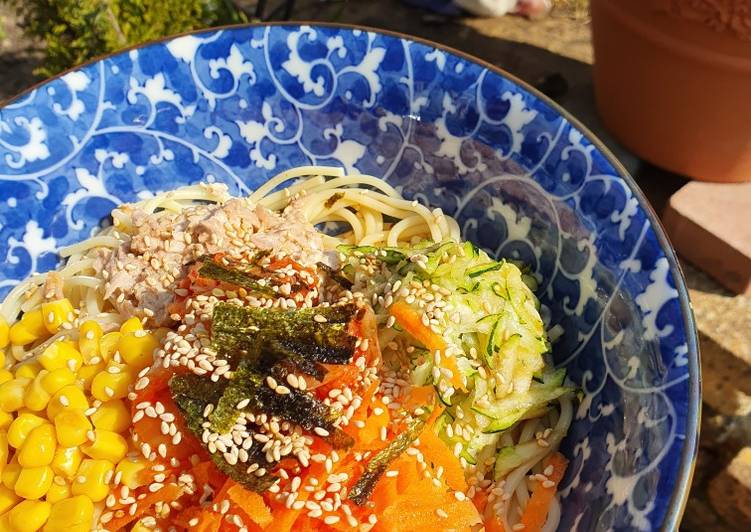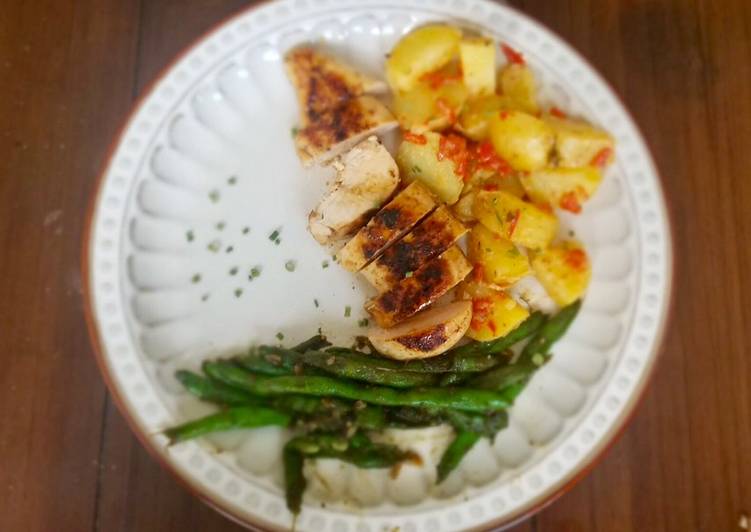
Hello everybody, it’s Brad, welcome to my recipe site. Today, I’m gonna show you how to make a special dish, japanese reimen (chilled noodles). It is one of my favorites food recipes. This time, I’m gonna make it a little bit unique. This will be really delicious.
Hiyachi Chuka literally means "chilled Chinese"; however, it is a Japanese dish with chilled ramen noodles and various colorful toppings. There are several chilled variations that can be enjoyed in the notoriously hot Japanese summer months. With Japanese cooking, everything appeals to the senses.
Japanese Reimen (chilled noodles) is one of the most favored of current trending meals in the world. It is easy, it is fast, it tastes delicious. It is appreciated by millions daily. They are nice and they look fantastic. Japanese Reimen (chilled noodles) is something that I’ve loved my entire life.
To begin with this particular recipe, we have to first prepare a few components. You can have japanese reimen (chilled noodles) using 17 ingredients and 5 steps. Here is how you can achieve that.
The ingredients needed to make Japanese Reimen (chilled noodles):
- Get 400 g spaghetti or noodles
- Prepare Tare (sauce)
- Get 6 tbsp rice wine vinegar
- Prepare 5 tbsp soy sauce
- Take 2 tbsp soft brown sugar
- Take 1 tbsp sesame oil
- Make ready Toppings (feel free to experiment - it should be colourful)
- Prepare Cucumber (grated or thinly sliced into matchsticks)
- Prepare Ham (sliced thinly)
- Make ready Egg crepe omelette (thinly sliced)
- Take Beansprouts
- Make ready Crab sticks (torn into strips)
- Take Sweetcorn
- Get Grated carrot
- Prepare Sriracha tuna mayo
- Get Sesame seeds
- Make ready Nori seaweed (torn or cut into strips with scissors)
I guess the reason for calling it chūka is because the noodle is the same as ramen noodle, i.e. Chinese egg noodle (ramen is also called "chūka soba" meaning Chinese noodles); and it was necessary to distinguish between cold Japanese noodles such as. Called men (麺) in Japanese, noodles are a staple in Japanese cuisine. Often viewed of as convenient food, the many types can be enjoyed chilled with dipping sauces, in soups, stir-fried or in salads.
Steps to make Japanese Reimen (chilled noodles):
- Boil the noodles or spaghetti according to instructions. Once it is cooked, drain the noodles and run under cold water until the noodles are cold throughout.
- Prepare your toppings. There are some suggestions in the ingredients list above but feel free to experiment. The bowl should look colourful so try using vegetables of different colours.
- Prepare the tare (sauce). Mix all the sauce ingredients in a jug and mix well until all the sugar is dissolved.
- Split the noodles/spaghetti into four large bowls. Place the toppings over the noodles in sections. Pour the sauce over the top and sprinkle sesame seeds and nori.
- Serve with chopsticks. Mix the ingredients in the bowl together to enjoy!
This article will guide you through every type of Japanese noodle you may encounter, though of course, there are countless regional varieties to each type of noodle. Never heard of this type of Japanese noodles? Thin light wheat flour noodles, hiyamugi are somewhere in between somen and udon noodles in terms of size, although they are eaten in the same types of dishes. To me, at this moment in time, hiyashi chuka just makes sense. Not only is the Japanese chilled noodle salad absolutely refreshing - a must during these sweltering days of summer - but it also features the sweetest, crispest vegetables available at the market right now: tomatoes, corn, cucumbers.
So that’s going to wrap it up with this special food japanese reimen (chilled noodles) recipe. Thank you very much for reading. I am sure that you will make this at home. There is gonna be more interesting food in home recipes coming up. Don’t forget to save this page on your browser, and share it to your family, friends and colleague. Thank you for reading. Go on get cooking!


